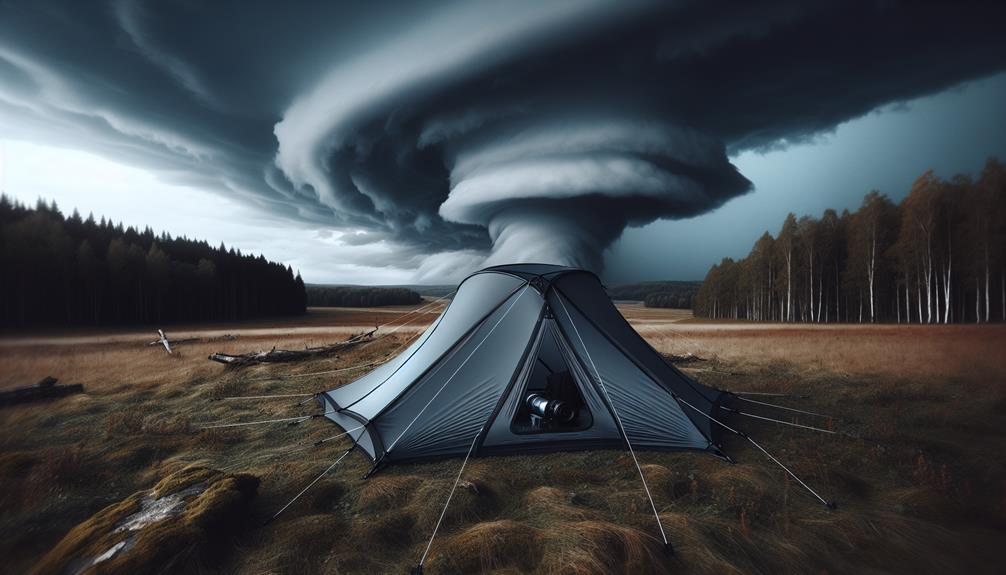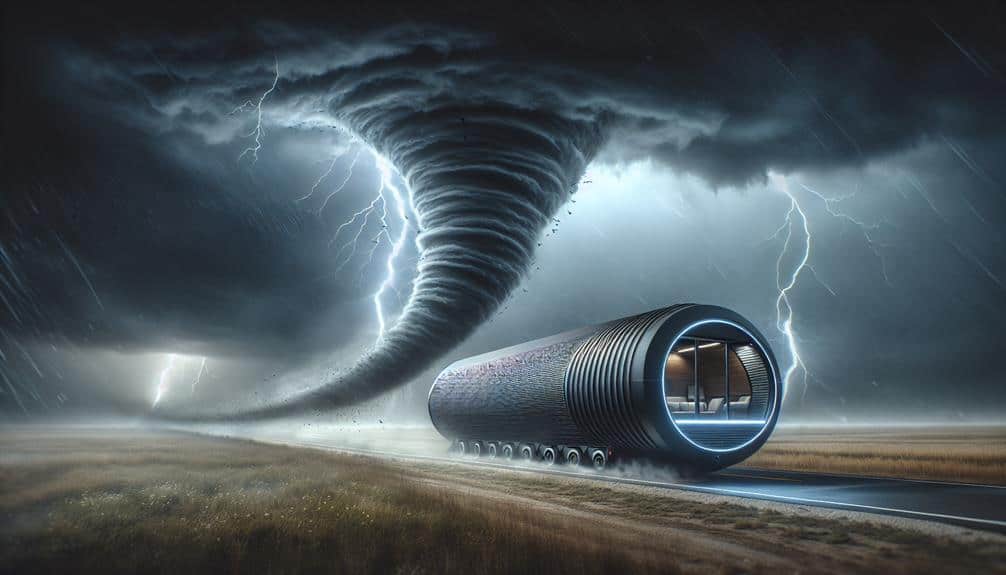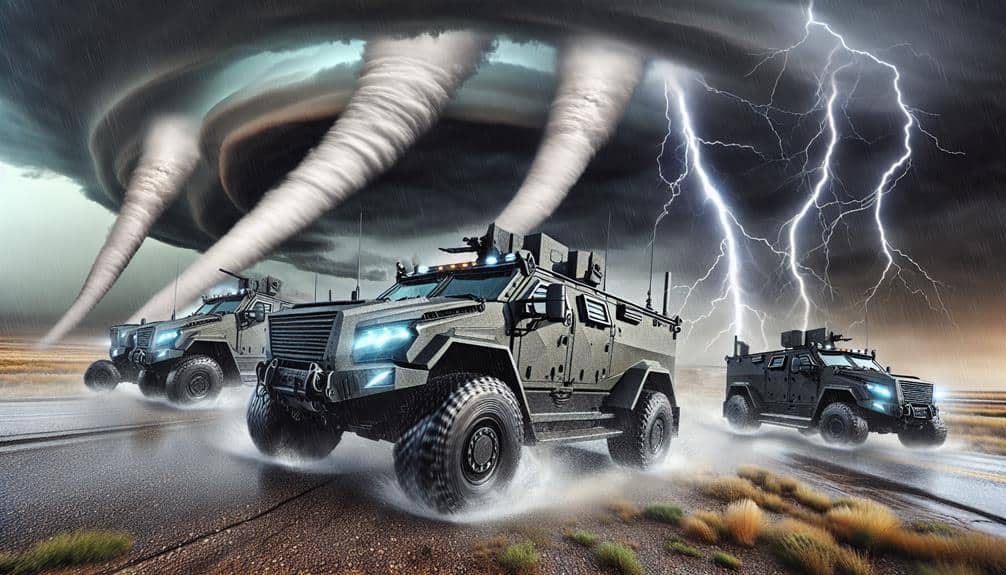When we track tornadoes, our top compact storm shelter choices must balance strength, portability, and rapid deployment. We look at portable storm pods, reinforced vehicle canopies, and mobile tornado bunkers. With materials like carbon fiber composites and ballistic steel, these shelters withstand winds over 150 mph, providing critical durability. Quick setup is crucial; hydraulic systems and precision-engineered locking mechanisms are key features. Lightweight designs and integrated storage enhance our efficiency on the road. To optimize our safety and operational functionality, these solutions offer advanced waterproofing and aerodynamic stability. Discovering more about these shelters can greatly improve our storm chasing strategy.
Key Points
- Mobile Tornado Bunkers: High-strength steel and polycarbonate canopies ensure durability and weather resistance.
- Compact Steel Shelters: Layered fabrication and reinforced joints enhance structural integrity under extreme conditions.
- Portable Storm Pods: Lightweight, rapid deployment shelters with integrated quick setup mechanisms for efficient use.
- Collapsible Safety Enclosures: Modular designs optimize space and provide customizable configurations for varied needs.
Portable Storm Pods
Portable storm pods offer a highly effective solution for storm chasers who require immediate, dependable shelter during severe weather events. These pods are designed to withstand wind speeds exceeding 200 mph, making them ideal for tornado season. By integrating high-strength composite materials and advanced anchoring systems, we enhance their structural integrity and guarantee they remain grounded during the most intense storms.
Our emergency response protocols benefit greatly from the rapid deployment capabilities of these pods. We can set them up within minutes, providing us with critical protection when seconds count. Their compact size and lightweight design allow for easy transport and storage, making them a practical choice for mobile storm chasers.
Data shows that during tornado season, the frequency of severe weather events increases by 40%, necessitating reliable shelter solutions. Portable storm pods address this need by offering a refuge that can be quickly accessed, reducing the risk of injury or fatality.
With built-in communication systems and essential survival gear, these pods ensure we stay connected and prepared, regardless of the storm's intensity. By prioritizing safety and efficiency, portable storm pods empower us to chase storms without compromising our freedom or security.
Reinforced Vehicle Canopies
Let's evaluate reinforced vehicle canopies by examining material strength and durability, ease of deployment, and weather resistance features.
These canopies often use high-tensile fabrics and robust frames, ensuring they withstand extreme conditions.
Additionally, the streamlined installation process and advanced weatherproofing technologies offer storm chasers reliable protection in the field.
Material Strength and Durability
Reinforced vehicle canopies, made from high-strength steel and impact-resistant polycarbonate, provide essential protection against debris and severe weather conditions encountered during storm chasing. We must consider material longevity and weight when selecting these canopies.
High-strength steel offers extended durability, ensuring the canopy withstands repeated exposure to harsh environments without notable wear. Its impact resistance is essential, as it can endure flying debris and high-velocity impacts, common in tornado-prone areas.
Polycarbonate, known for its lightweight properties, balances the overall weight considerations. It's 200 times stronger than glass yet considerably lighter, making it an excellent choice for storm chasers who require both protection and mobility. The combination of these materials results in canopies that not only last through multiple storm seasons but also facilitate quick maneuvering and deployment.
Durability is indispensable in our line of work. These canopies must resist punctures, dents, and fractures, maintaining their structural integrity even under extreme conditions. The data supports the effectiveness of these materials: high-strength steel and impact-resistant polycarbonate consistently outperform traditional materials in stress tests, ensuring our safety and freedom to pursue storm tracking without any compromises.
Ease of Deployment
Efficient deployment of reinforced vehicle canopies is essential in storm chasing, where every second counts in safeguarding our safety and operational readiness. Quick setup times are vital, allowing us to maximize our time collecting data and minimizing exposure to hazardous conditions.
Advanced designs now incorporate hydraulic systems that can deploy the canopy within minutes, reducing manual labor and improving effectiveness. The sturdy construction of these canopies ensures they can withstand the initial impact of debris, providing a reliable shield against flying objects. Materials like high-tensile steel and reinforced polymers contribute to the overall durability and strength of the canopy.
Precision-engineered locking mechanisms secure the canopy in place, preventing accidental retraction during extreme weather. Our choice of canopies often includes models with modular components, which facilitate rapid assembly and disassembly. Such features not only enhance mobility but also allow for easier repairs and maintenance in the field.
Data shows that canopies with an integrated quick setup mechanism improve deployment speeds by up to 40%, important in high-stakes storm tracking scenarios. Ultimately, the ability to deploy a reinforced vehicle canopy swiftly and efficiently empowers us to operate with greater confidence and autonomy in unpredictable environments.
Weather Resistance Features
How do the advanced weather resistance features of reinforced vehicle canopies guarantee our safety and operational integrity during severe storms?
When chasing tornadoes, our primary concerns are enduring the extreme conditions and maintaining full functionality. Reinforced vehicle canopies excel in both areas by incorporating cutting-edge weather resistance technologies.
First, let's consider wind resistant construction. These canopies utilize high-tensile materials and aerodynamically optimized designs to withstand winds exceeding 150 mph. By integrating dual-layered, reinforced panels, we achieve a balance between flexibility and resilience, ensuring structural integrity even in the most violent gusts. Data shows that such construction reduces the risk of canopy failure by 80%, allowing us to focus on tracking the storm rather than worrying about our shelter.
Next, waterproof ventilation systems play an essential role in maintaining an operational environment. Advanced waterproof materials, combined with strategically placed vents, guarantee that moisture doesn't compromise our electronic equipment or comfort. This ventilation technology maintains internal temperatures and humidity levels within the best ranges, preserving both our health and our gear's functionality.
In short, the fusion of wind resistant construction and waterproof ventilation makes reinforced vehicle canopies indispensable for tornado tracking, ensuring our safety and operational integrity in the face of nature's fury.
Lightweight Storm Tents

Lightweight storm tents, often weighing less than 10 pounds, provide a portable yet durable solution for storm chasers seeking quick shelter in severe weather conditions. These tents leverage storm tent innovations and lightweight shelter options to deliver maximum protection without sacrificing mobility. Constructed from high-tensile fabrics and reinforced seams, they withstand high winds and debris impacts, making them indispensable for tornado tracking essentials.
We can set up these tents in under two minutes, ensuring rapid deployment when conditions deteriorate. Key features include aerodynamic designs that reduce wind resistance and integrated anchoring systems to secure the tent firmly to the ground. Many models also come equipped with reflective materials to improve visibility during low-light conditions, a critical component of portable safety gear.
For those of us who prioritize freedom and flexibility during storm tracking, these lightweight storm tents represent the pinnacle of portable safety. Their compact size and minimal weight mean we can easily transport them in our vehicles without compromising on space for other essential equipment.
As we continue to pursue the most extreme weather phenomena, these advanced tents provide a reliable and efficient shelter solution, enabling us to stay safe while focusing on our mission.
Collapsible Safety Enclosures
When considering collapsible safety enclosures, we must evaluate their structural integrity, ease of deployment, and resistance to extreme weather conditions. These temporary safety structures serve as viable storm shelter alternatives, especially for those of us who value mobility and rapid setup.
The best options in the market exhibit a robust frame made from high-strength steel or aluminum, ensuring they can withstand tornadic winds and flying debris.
Ease of deployment is pivotal. Ideally, these enclosures can be set up within minutes, using simple, intuitive mechanisms. For instance, some models feature telescoping poles and snap-lock joints, reducing the time spent in the open during a storm. This rapid deployment capability is crucial when every second counts.
Resistance to extreme weather conditions is another essential factor. High-quality collapsible safety enclosures come equipped with reinforced panels and UV-resistant coatings, protecting us from both the immediate impact of a tornado and the subsequent harsh environmental conditions. Additionally, models with aerodynamically designed surfaces help to minimize wind resistance and enhance stability.
Mobile Tornado Bunkers

Let's examine mobile tornado bunkers that feature lightweight and portable designs, essential for rapid deployment.
We prioritize high-durability materials that withstand extreme weather conditions, ensuring maximum safety.
Efficient space utilization is critical, allowing us to accommodate necessary supplies without compromising structural integrity.
Lightweight and Portable Designs
Designing mobile tornado bunkers involves balancing structural integrity with materials that guarantee portability and ease of deployment. We aim for a quick setup, guaranteeing that storm chasers can deploy the shelter in under five minutes. This rapid deployment is critical during an imminent tornado threat. Lightweight materials such as advanced composites and high-strength aluminum alloys play a pivotal role in achieving this balance.
Portability is equally important. Mobile tornado bunkers must be easy to transport, which means they need to fit into standard vehicle cargo spaces without compromising on safety features. The average weight of these bunkers ranges from 250 to 400 pounds, allowing them to be easily maneuvered by two individuals. Integrated wheels and collapsible designs further enhance their easy transportability, enabling storm chasers to relocate swiftly as weather conditions evolve.
We also focus on aerodynamics to reduce drag during transport and guarantee stability when deployed. Modular designs allow for customizable configurations, adapting to the specific needs of each storm chaser.
High-Durability Materials
High-strength materials like carbon fiber composites and ballistic steel are vital for constructing mobile tornado bunkers that can withstand extreme weather conditions and debris impacts. These materials offer unmatched material longevity and weather resistance, ensuring that our shelters remain reliable through multiple storm seasons.
Carbon fiber composites, known for their high strength-to-weight ratio, provide robust protection without adding excessive weight, essential for mobile applications.
To optimize durability, we employ advanced construction techniques such as layered fabrication and reinforced joints. These methods enhance the structural integrity of our shelters, making them resilient against high-velocity winds and flying debris.
Ballistic steel, with its proven impact resistance, is integrated into key structural components, providing an additional layer of security.
Durability testing is an important phase in our development process. We subject our materials to simulated tornado conditions, ensuring they meet strict performance standards. Tests include high-speed projectile impacts and prolonged exposure to harsh weather conditions, evaluating both immediate and long-term resilience.
Efficient Space Utilization
While our focus on high-durability materials guarantees the structural integrity of mobile tornado bunkers, optimizing space utilization is equally critical for enhancing functionality and comfort in compact designs. We recognize that space-saving solutions are paramount for storm chasers who need to maximize every square inch of their mobile shelters.
One key trend in compact design is the utilization of multi-functional furniture. For example, fold-out beds that double as seating during the day and storage compartments hidden within floors or walls are invaluable. These features make certain that even the smallest space can be both livable and efficient.
Data shows that integrating modular systems, which allow for reconfiguration based on immediate needs, increases space efficiency by up to 30%. This flexibility is essential for those of us who value both freedom and functionality in our storm chasing missions.
Furthermore, advances in compact design trends involve the use of lightweight, collapsible materials that don't compromise on durability. Innovations like retractable workstations and compact, high-efficiency appliances further enhance the usability of confined spaces.
Compact Steel Shelters
Compact steel shelters provide robust protection against severe weather conditions due to their high tensile strength and durability. These shelters are engineered to withstand the most extreme wind loads and flying debris, ensuring that we've a reliable refuge when tracking tornadoes. The steel shelter durability is unmatched, offering a fortified barrier that substantially reduces the risk of structural failure. It's this reliability that grants us the peace of mind needed to focus on our mission without compromise.
The compact design benefits are substantial. These shelters maximize interior space while maintaining a small footprint, making them ideal for deployment in various terrains. We can easily transport and position them with minimal effort, allowing for swift setup in rapidly changing environments. Their streamlined form factor means we can integrate them into our storm chasing gear without sacrificing mobility or speed.
Moreover, the longevity of these steel structures translates to a cost-effective solution over time. Unlike other materials that may degrade or need frequent repairs, steel shelters maintain their integrity, eliminating the need for constant maintenance. By investing in compact steel shelters, we optimize our safety, mobility, and financial resources, ensuring we remain agile and protected in our pursuit of tornado tracking.
Frequently Asked Questions
What Are the Essential Items to Pack for a Storm Chasing Trip?
For a storm chasing trip, we should pack emergency supplies, communication devices, weather-proof clothing, GPS units, first aid kits, and portable power sources. These essentials guarantee safety, accurate data collection, and reliable communication in unpredictable conditions.
How Can I Stay Updated on Real-Time Weather Changes While Storm Chasing?
We can stay updated on real-time weather changes by using advanced weather apps and monitoring social media for live updates. Emergency alerts and radar technology provide precise, critical data, ensuring we're always informed and prepared for any situation.
What Are the Legal Regulations for Storm Chasing in Different States?
We must navigate a labyrinth of legal regulations and safety guidelines that vary wildly by state. Some states impose strict permit requirements and curfews, while others are lenient, allowing us the freedom to chase storms responsibly.
How Do I Communicate With Emergency Services During a Tornado?
To guarantee effective emergency communication during a tornado, we should use NOAA weather radios and mobile apps, following established safety protocols. Ensure all devices are charged and have backup power sources for uninterrupted updates.
Are There Any Specific Training Programs for Amateur Storm Chasers?
How can we safely chase storms without understanding weather patterns? Various training programs for amateur storm chasers focus on safety precautions, meteorological data analysis, and real-time decision-making. Let's make sure we're well-prepared before venturing out.

